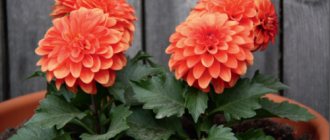Author: Natalya Category: Houseplants Published: January 03, 2019Republished: February 04, 2019Last edits: January 11, 2021
- Care during flowering
- Zygopetalum intermedium
Zygopetalum (lat. Zygopetalum) is a small genus of epiphytic, terrestrial and lithophytic plants of the Orchidaceae family, growing in tropical regions of South America, with most of the representatives of the genus coming from the rainforests of Brazil. There are only 15 species in the genus, and some of them are so popular in indoor culture that breeders had to start developing varieties and hybrids of zygopetalum. The name of the genus is derived from the Greek words, which are translated as “gather in pairs” and “sepal” (“petal”), and characterizes the structure of the zygopetalum flower.
Description and distinctive features
Let's take a closer look and find out what the Zygopetalum orchid looks like: description and care at home:
- In the genus Zygopetalum only 15 types. The translation doesn't explain much. They are like “connecting sepals.” These are not like butterflies;
The Zygopetalum orchid is a very beautiful and rare flower. - Even experts consider this species to be rare ;
- If you like detective stories. Nero Wolf mentions this plant in his works. Here she is “Miss Tropics”. Flexible and curved;
- Experts are more inclined to believe that this type of orchid is rather capricious . And they add. As in the whole family, there are no simple ones.
Consider the plant itself:
- It is formed in the form of a ladder escape. And in the pot there seems to be a nest of several pseudobulbs. New ones appear a little above and to the side of the old ones. What is a pseudobulb : Orchid stems thickened at the bottom;
- Green, smooth, elliptical (oval) shaped formation;
- 6-7 cm long (height). Flattened.
Please note! Flower shops OBI and IKEA will most likely offer you interspecific hybrids - Zygonisia, Zygolum .
Main types
It is quite rare to find the original species of zygopetalum in flower shops; as a rule, only interspecific hybrids can be found there. Below are characteristics of several main types.
Zygopetalum maculatum
The peduncle is 40 centimeters long and bears 8–12 flowers, which reach 4 to 5 centimeters in diameter. The sepals and petals are elongated-obovate, with a slight expansion at the tips. They are painted greenish, with many shapeless specks of burgundy color scattered over the entire surface. On the white lip there are intermittent longitudinal stripes of a purple hue.
Zygopetalum pedicellatum
This type is similar to the previous one. However, it differs in that the narrower lip has a purely white wide part, while on the surface of the base, as well as on the remaining narrower area, there are a large number of small purple dots.
Zygopetalum maxillare
On a long peduncle (about 35 centimeters) there are 5–8 large flowers with a diameter of 6 centimeters. The 2 sepals located below are almost completely colored burgundy-brownish, while only in some places the main green color can be seen. From the middle to the base, the 3rd sepal and true petals are painted in the same burgundy-brownish hue, the second part is green, and there are large brownish-burgundy spots on it. The lip has a smoothly changing color. So, it changes from purple-white at the tip to a dark purple hue at the base.
Zygopetalum triste
The peduncle can reach 25 centimeters in length, while the flowers have a diameter of 5 to 6 centimeters. The narrow, almost belt-shaped petals and sepals have a uniform brownish-burgundy color. At the same time, at their base there are green spots. The snow-white petal has stripes-veins of a blurry purple color.
Zygopetalum pabstii
This species is the largest of all in this genus. It has very long peduncles, reaching a height of 0.9 meters, and also has large flowers (diameter approximately 10 centimeters). The sepals and petals have a color similar to most representatives of the genus Zygopetalum. So, on the green surface there is a large number of burgundy-brownish spots. The white lip is almost completely covered with many blurred veins-stripes of purple color.
Varieties of Zygopetalum orchid
Mackay
- The most famous . Maybe popular;
- His mistresses consider him the most beautiful ;
- Still would. White lip with purple or reddish lines and dots;
- Very often used for breeding new varieties . With her participation there are already more than 20 of them.
Zygopetalum mackaii.
Also Mackay.
Maxillare. Zygopetalum maxillare
- The violet color disperses evenly into a faint violet tint towards the edges of the lip;
- The length of the peduncle reaches 35 cm . Each has 6-8 flowers;
- The burgundy-brown color almost completely covers the green petals at the base.
Z. maxillare.
Blue Angel
Those who saw it in person remembered more than the color. And the aroma. It reminded them of ground black pepper.
Zyg. Rhein Blue Angel.
Luisendorf. Zygopetalum Louisendorf
Very sweet aroma . They even take him out of the bedroom. Ardent lovers of these flowers.
Zig. Louisendorf.
Kinds
There are 14 main varieties and many hybrids. Breeders are constantly developing new hybrid orchid combinations.
| View | Peculiarity |
| Luisendorf | Prized for its strong sweet aroma. Blooms for 3 months, petals are burgundy-brown with a green base. There are up to 8 buds on one stem. |
| Blue Angel | The color of the inflorescences is blue with hints of lilac and splashes of cream. Difficult to care for variety. The aroma is reminiscent of black pepper. |
| Trosy Blue | The leaf blades are long, the flowers are yellow-blue or white with burgundy specks. The petals are varied, ranging from thicker to thinner. |
| Mackay | Epiphyte, bright throughout all seasons. The flowers are openwork, light green with brown speckles, and the lip is white with spots of red. |
| Maxilyare | The inflorescences are brown with a green border, the lip turns purple or white. |
| Maculatum | Petals are light green with chocolate spots. The white lip is covered with purple streaks. |
| Pabstii | The largest variety, height up to 90 cm. Buds up to 10 cm in diameter. |
| Pedicellatum | It is distinguished by a narrow white lip covered with lilac specks. |
| Microphytum | Blooms longer than other varieties. Height no more than 25 cm. |
| Shaggy | The inflorescences are fragrant, with wavy light green petals. The lip is covered with longitudinal purple streaks. |
| Alan Greatwood | The buds are large, chocolate-colored. The lip is wide, purple at the base, white with purple specks below. |
| Arthur Elle Stonehurst | The petals are dark cherry in color, and the lower part of the flower is burgundy with a white border. |
| Merlin's Magic | It is distinguished by the light green color of its inflorescences with merging chocolate spots. |
Homeland and territory of distribution in nature
The nature of South America has gifted everyone with an amazing plant from the orchid family. The whole genus Zygopetalym (zygupetalum). The tropical rainforests of Brazil, Venezuela and Colombia have the most of them. But they grow:
- In Peru;
- Bolivia;
- Paraguay;
- And Mexico.
For us they are a curiosity. Feels great :
- On the trees;
- Stones;
- Earth.
And it is not a parasite in relation to other plants. In nature, these are epiphytic and lithophytic plants :
These extraordinary orchids grow on trees, rocks and the ground.
- Epiphytes (Greek: “on plants”) are plants that grow or are attached to other plants (trunks or branches). And it does not receive any nutrients . They are not parasitic;
- Lithophytes (from the Greek “stone” and “plant”). Plants that have adapted to life on stones and rocks (dolomite, limestone, marble). There are more of them in the cracks .
Methods for propagating zygopetalum orchids indoors
Dividing the bush.
This method of propagation is applicable to mature, well-grown plants. Division is carried out during transplantation; the soil must be completely dry before the procedure. The roots of the zygopetalum orchid are completely freed from the substrate and carefully untangled; severely tangled areas are cut with a knife, and the cut areas are treated with crushed charcoal or activated carbon.
When dividing, it should be taken into account that each division must have at least 3-5 pseudobulbs. Each young specimen is planted in its own container and immediately placed in its usual place for growth. After the division procedure, the plants are not watered for at least a week. Such young zygopetalums of this species sit in place for a very long time and have difficulty taking root.
Reviews
Natalia. “My story as a florist is similar to many. There were several pots of violets on the windowsill. Even ordinary watering was not part of my duties. I was not puzzled. But she didn’t show any initiative. Growing up, my attitude towards flowers changed. These flowers brought comfort and beauty. And now the collection includes flowers whose names many cannot pronounce correctly. Things don't always work out. There are also miscalculations. Some of them couldn't even be saved.
But there is already solid experience. Including the maintenance and care of orchids. Many friends ask for advice. I'll be happy to explain. After my stories, some people got their own orchids. Fears about complex care are already a thing of the past. More than a dozen phalaenopsis.
And now Zygopetalums have already appeared. They are even easier to care for. What can you grow without desire? And it doesn’t matter that some don’t have names. They are just white, pink, yellow. Such beauty is worth the effort, effort, and money.
So I advise many to put aside doubts about orchids. In reality, everything is much simpler. It is imperative to create the necessary conditions for these beauties. To admire beautiful flowers. It's within your power.
I do not recommend using clay pots. Roots can grow into them. And get damaged during transplants.
I don’t recommend buying and transporting orchids in the cold winter.”
Alexander. “I already have good experience in growing orchids. Almost ten years. There are now much more opportunities to acquire them. Take the Internet, for example. Varieties. Care. Everything for growing them (pots, soil, fertilizers). Detailed care tips. I will note on my own behalf. There are enough contradictory ones. For some they are suitable. I want to share my observations. I water the flowers without immersing the pots in water. I spill it around the edges of the container. Until water flows out of the pot.
I pay special attention to high-quality lighting. There are many flowers. Lights for each shelf. After the store I will definitely replant it. I select convenient containers. I completely replace the soil. I carefully examine the roots. I definitely remove dried and damaged ones.
Now they like to add coconut shavings to the soil. I'm deleting it. And I advise you. The soil must contain fine coniferous bark, peat, perlite and charcoal. Keep in mind. The roots are fragile and break easily. I definitely feed it with humus fertilizers (Gumate-7). 2 times a month. Without this you cannot see flowers.
And remember. The soil should not be allowed to dry completely. They are from the humid tropics."
Marina. “My orchid lovers and I came to the same conclusion. Don't be afraid to buy them. Although not exactly cheap. Our conditions allow us to provide them with conditions for flowering. Of course, we need to take care of this. Reading reviews also helps a lot. There are a lot of people there: “Oh, I bought this beauty. What is this? And what to do next?
But there are a lot of useful tips. Some of my friends place this orchid on loggias in the summer. Even in gazebos. And they bloom! I want to try it myself.
High humidity (about 60%) needs to be constant. And I water it often. Moderately. That's why I ventilate the rooms often. It is necessary to carefully monitor the condition of the soil.
Every month I feed it with humus. Be careful with nitrogen fertilizers. They can burn the roots. How can you determine the condition of the soil. And the need for watering. Root color (grayish). The moisture is gone - the weight is lighter.
About lighting and backlighting. Excessively bright lighting promotes rapid growth of flower stalks. But the pseudobulbs lag behind and do not have time to ripen. This negatively affects the ability to bloom in the future. Low light does not allow them to bloom. We need a golden mean.”
Transplantation of zygopetalum
How to transplant zygopetalum photo
In indoor conditions, it is better to grow zygopetalum in a container filled with a suitable substrate. It should absorb liquid well and allow air to pass through. Most often, flower growers purchase a special substrate for orchids in the store. If desired, prepare the mixture yourself: fine pine bark, sphagnum, expanded clay, peat. The roots of such an orchid can grow into any clay surface, which will complicate subsequent replanting. It is better to take a plastic pot; it should have good drainage holes.
Zygopetalum is grown on a block of bark mainly in orchidariums or greenhouses, because it will be necessary to maintain a constantly high level of air humidity. The block is a large piece of pine bark. Secure the roots to the surface of the block, lay a thin layer of coconut fiber or sphagnum on top.
Replant as necessary (when the plant has already grown greatly, the roots have spread beyond the container). Carefully remove the orchid from the substrate, cut off the dried and rotten parts of the roots, and treat the cut areas with a fungicide. Also cut off completely dried pseudobulbs. If the pseudobulb has simply shriveled and lost its attractiveness, there is no need to cut it off - it contains the nutrients the orchid needs to maintain growth.
External characteristics
Florist specialists classify it as a group of horizontally growing plants.
They are called sympodial (from the Greek “together” or “many”):
- This orchid has several growing points. Shoots grow from them and transform into pseudobulbs;
- So they disperse across the width of the pot. Towards its edges, in the photo you can see this;
- United by one rhizome (rhizome);
- From these growths, as it were, 2-4 leaves grow. And a peduncle.
This orchid has several growing points, from which several shoots are formed.
On a note! Pseudobulba lives 2-3 years. Having formed a peduncle and given it the opportunity to bloom, it itself no longer grows. A new shoot usually appears at the base.
The difference between monopodial orchids (phalaenopsis) is that the leaves grow one above the other . And the peduncle grows from the axils of the leaves.
Mature plant height
It must be specified. So that they do not mistakenly think that the orchid is creeping. And choose the appropriate place . And the grown leaves and flower stalks necessarily bend.
Number of leaves
Quite a lot of leaves are formed . Few people count them. But to control the condition of the plant, you need to know. Each pseudobulb produces 2-4 leaves. And the bush looks solid.
Maximum peduncle length
And they grow up to 50 cm with proper care and conditions . There can be up to 8 pieces on perennial plants. And each has 6-10 flowers.
Can you imagine such a bouquet? You will see and believe.
Diameter, flower shape
7-8 cm will be exactly. On the line. If you measure it. The way it is. There is more on the Internet. Especially in the price lists of selling companies and entrepreneurs .
But it's not the size that surprises. And its shape. Five elongated petals of course. But most of all the lip. He even calls it spade-shaped . I prefer the comparison with a fan.
Description
A distinctive feature of Zygopetalum is the presence of a characteristic thickening (pseudobulb) up to 5-7 cm in size at the base of the stem, in which nutrients are deposited “in reserve” during the growth process. The root system is powerful, the leaf blades are wide, smooth, and uniformly green. Up to 10 brightly colored flowers with a pleasant aroma bloom on a tall peduncle. The range of colors of Zygopetalum is quite wide, there are various shades of brown, green, purple, and burgundy.
Main features of flowering
Nature is difficult to understand. When does it start to bloom? How long does it bloom? Are there these periods of rest? What does repeated mean? There are a large number of them there. Constant climate . In the tropics, some have just bloomed, while others have already faded. But it blooms on not yet fully formed pseudobulbs.
Period
In an apartment, we create the conditions ourselves . Two blooms per year. And they were accustomed to the intervals between flowerings (dormant periods). This may not be the correct wording.
Duration
You always want the flowering to last for a long time . You will definitely be able to see the flowers for 5-6 weeks. On one peduncle. And then how to grow.
Is it possible to do it again?
Amateur flower growers talk not only about repeated flowering. They call them periodic . And there. Who cared how? But two flowerings a year are considered a great success. At home.
Stimulation
How to stimulate flowering? There are most questions about this in the reviews . After all, they bought it to admire the flowers. And not by roots:
- Feeding with humus is very useful;
- Lowering the temperature to 14-18 degrees seems to push the plant towards this process;
- Reduce lighting time by 2 hours. Within 3-4 weeks.
Fertilizers and fertilizers
Zygopetalum, like all flowering plants, needs phosphorus and potassium . However, standard potassium-phosphorus mixtures are not suitable for feeding orchids. Mineral salts destroy sensitive roots.
As fertilizers for Zygopetalum, you should use formulations developed specifically for orchids, and in a dosage of ½ or even ¼ of the norm specified in the instructions. The plant is fed during the period of active growth with a break of 15-20 days of the week. Fertilizers are applied by foliar spraying or by dipping in a nutrient solution during watering. After feeding, the substrate is washed with warm water, taking into account that the orchid is a child of the air, which means it cannot tolerate stagnation of water in the soil.
Doctor of Biological Sciences, author of the book “Orchids and the peculiarities of their cultivation” Galina Kolomeitseva.
Important! After flowering has completed (during the first week), it is necessary to carry out maintenance feeding to restore the plant’s lost strength. Then the orchid should be provided with a rest period of 1.5-2 months without fertilizing, with minimal watering and a decrease in the average daily air temperature.
Maintenance and care
Optimal conditions of detention
Home care is a very painstaking job for a beginner. How to keep such an orchid in your apartment. What conditions? Remember. Where did it come from? What are the conditions there? And your hybrids are even more stable. I would like to draw your attention to two concepts :
- Useful and recommended terms . When the plants bloom and smell;
- Portable conditions . This is when they can withstand unexpected peaks and surges without any serious consequences: For zygopetalums, there is no need to be too clever. A damp and cool environment is quite suitable : 15-25 degrees during the day are more beneficial. And at night it’s about 15 degrees;
- And the rest period during the day is 16-18. And at night 13-16 degrees.
- Pallets with wet expanded clay;
- Neither south nor north. So pick up the southeast. Or just east;
Replanting after shopping in a store
Needs to be replanted. Although these orchids do not respond very well to transplantation. And what prompts this. You don't know the condition of your plant :
- What roots? Refresh and disinfect;
- And in most cases the soil is temporary. And abundantly watered by sellers. So as not to dry out;
- And it's better to change it. Prepare yours. Home.
Watering and fertilizing
Two irrigation options are used . After the procedure, you are given the opportunity to dry. When the roots are covered with velamen. The second option does not involve drying.
Take filtered water . Better rain and settled. Use a cocktail of distilled and settled water. Fifty fifty. The salts in the water only harm the leaves. And the roots.
Attention! A coating (white or yellowish) may appear on the leaves. Can be removed with milk. And a solution of citric acid will help.
When flowering, water more :
- Usually - once a week. Spring and autumn;
- 1 time every 3 days in summer;
- Once every 12-15 days – in winter.
Orchidists (or orchomaniacs) advise. almost daily in the summer . A little. Or moderately. It is easier to keep the soil moist.
Watering methods:
- Immerse the pot in water for 15-20 minutes. Leave to drain;
- And all in the morning. Every day is very good. Little by little.
Advice! Do not let the soil dry out completely. Let it be a little damp. Like in the tropics. The plant compensates for the lack of moisture from leaves and pseudobulbs. This dehydrates them and prevents them from flowering.
What needs to be fed is Zygopetalum:
- And not just anything. And more specifically. Humus. Without it, don’t even dream of flowering;
- Diagram of specialists. Before flowers appear - phosphorus and potassium. After flowering - nitrogen;
- Read the ingredients of the fertilizers you buy! At your discretion and decision - once every 2-3 weeks.
Stimulating flowering
A drop in temperature is not dangerous. And even useful. If it's not important. It can just contribute to the emergence of new flower stalks .
After flowering, what to do with the arrow?
There are no more flowers. They have bloomed. Assess the condition of the peduncle . It starts to dry out. And pseudobulb. But she should have young shoots. Future pseudobulbs and peduncles. Remove them after drying.
Watering should be reduced. Can also be placed in cooler places. To activate the formation of flower stalks .
Prevention of diseases and pests
Think about proper care. And provide the necessary conditions :
- Temperature;
- Illumination;
- Humidity;
- Containers for plants;
- Suitable soil;
- Timely watering, fertilizing and replanting.
Then you will deal less with diseases and pests. But you need to know them. To promptly identify and take action :
- Diseases (more about them below);
- Pests. Just like regular flowers. Spider mite. A warm shower will help get rid of it. If necessary, repeat it.
Zygopetalum flowering
Care during flowering
The zygopetalum peduncle appears next to the pseudobulb, which has barely begun to develop, which stops growing during flowering and resumes its development after flowering. If growth has developed, but flowering has not occurred, then it is useless to wait for a flower from an already grown pseudobulb. However, with good care at home, flowers on the zygopetalum can form twice a year. During the flowering period, zygopetalum needs light shading.
Zygopetalum after flowering
The faded shoot needs to be trimmed so that it does not take away nutrition from the young pseudobulb, which has yet to develop into adult growth. After flowering is completed, continue to feed the zygopetalum with fertilizers with a predominance of nitrogen, and when the pseudobulb is fully formed, add a potassium-phosphorus complex to the substrate, after which you need to stop feeding, lower the temperature in the room (during the day - to 16-18 ˚C, and at night to 14- 16) and gradually reduce watering: the plant should rest and gain strength before the new growing season.
Landing
Priming
You already know. The roots of the plant are almost completely in the soil (almost 80-85%). They are covered with numerous root hairs . This provides moisture to the entire plant. And determines the soil requirements. Constantly wet and loose.
Optimal soil composition:
- Finely chopped tree bark;
- Charcoal;
- Perlite;
- Expanded clay;
- Sphagnum moss;
- Peat;
- The soil should not dry out.
They can also be grown on blocks. In the greenhouses. Coconut fibers and a thin layer of moss are just right there .
Optimal capacity
Plastic or clay pots. fit freely in them .
Provide good drainage :
- Expanded clay. Vermiculite;
- And there is one at hand. Fine and washed crushed stone. Small sea pebbles. And walnut skins.
Technology and timing
Repot your orchid only when necessary . For them, this is the period after flowering. Young roots grow more actively. These orchids do not like changing pots.
The technology is known and is not difficult :
- Prepare the container and soil;
- Carefully remove the plant from the old pot. As if shaking out;
- Remove old soil;
- Cut off damaged and dried roots and bulbs;
- Treat the cut areas with charcoal. And let them dry a little;
- Place drainage in a pot (expanded clay, perlite);
- Set the plant;
- Cover with soil.
Be careful! Pseudobulbs should be on the surface of the soil. Don't fill them up. Once every 3-4 years. Water every other day or two. Not earlier.
Transfer
This orchid does not need regular replanting; moving to a new pot will be required when a creeping shoot with pseudobulbs begins to hang over the edge of the container or the roots crawl out into all the drainage holes and onto the surface of the substrate. In this case, the shrunken or damaged parts are cut off, and the cut areas are sprinkled with powdered fungicidal preparations or charcoal.
Replanting when the peduncle is forming is unacceptable, as stress can cause the plant to shed its buds.
Substrate
Regular soil is not suitable for zygopetalum. It is necessary to purchase a substrate that meets the following requirements:
- permeable and friable;
- with the addition of perlite for better air exchange;
- with vermiculite to prevent caking.
It is best to purchase a high-quality ready-made substrate for orchids, consisting of coniferous bark, sphagnum and charcoal.
Pot
The main requirement is transparency. This is necessary because the roots develop bacteria necessary for normal growth, which live only in the presence of light. It is undesirable to use glass containers, as they can lead to overheating of the root system, but plastic ones will be just right. There must be large drainage holes at the bottom.
Landing technique
A drainage layer at least 5 cm thick must be placed at the bottom of the pot, after which the roots of the zygopetalum are placed in it and soil is carefully poured into the remaining voids.
The main nuance is that the root collar and pseudobulbs are not immersed in the substrate, as this can lead to rotting during cultivation.
After transplantation, the orchid is watered by immersion in warm water. The first month after this, no feeding is carried out.
Diseases and their treatment
Yellowing and lethargy of leaves
This could be a request to improve the lighting. Options for you to consider. Based on your conditions and capabilities :
- Backlight;
- Placement on the brighter sides.
Black spots on leaves and bulbs
for you to help :
- Is this not the characteristic coloring of the leaves?
- Maybe the plants are in the sun? Then sunburn is possible.
Fungal diseases
The fungal disease gray rot is very dangerous for orchids . The leaves become covered with dirty spots.
The roots have rotted. How to save?
In order to save an orchid, you must follow the rules:
- Prepare scissors and pruning shears. Process them ;
- Trim off any damaged parts;
- Treat (lubricate) with activated carbon . Let them dry for 2-3 days. Make sure there is no rot;
- You can equip a mini-greenhouse. Or keep it in a pot;
- Treat possible root growth points with a succinic acid solution;
- You can also use vitamins B1, B6, B12. It will take a lot of time. About six months. And patience.
Botanical description
The stem is creeping and grows like a ladder.
The shoots are tall, growing up to 50–60 cm in height. Pseudobulbs are short, up to 6 cm in length, oval, smooth. They have a bright green color. The structure is slightly compacted. Pseudobulbs are located in a nest of lower leaves, which subsequently die off. The leaves are shiny, pointed, wide, leathery, glossy. There are subcultivars with lanceolate leaves. The leaf blade has longitudinal veins. The peduncle is straight, up to 45–50 cm long, growing from the lower leaves. The inflorescences of the plant are brushes that form up to 12 buds growing sequentially. The flowers themselves are variegated and spotted. They have different colors: green, purple, white. There are monochromatic colors of petals. The lip stands out in contrast - large, bright purple or lilac.
Large flowers are fragrant. The root is dense and fragile. The shoots are white, thick, and grow in a spiral shape.
Reproduction
In fact, if you are growing a Zygopetalum orchid at home and if you do not have very in-depth knowledge and skills in the field of floriculture, then you should not even try to propagate this plant in any way other than by dividing the bush. Using this method, you also need to follow certain rules, but the most important of them is that at least three to four pseudobulbs should remain on each plot, which can ensure its stable growth and development, and also help it adapt to the new environment. Immediately after cutting, it is necessary to keep the plots outside for some time, which means that this procedure should be carried out exclusively in the spring (after all the frosts have passed), and best of all, in the summer. They are exposed to fresh air so that the cuts dry faster, and in order to speed up this process, it is necessary to lubricate them with garden varnish or sprinkle them with charcoal.
In theory, the Zygopetalum orchid can be propagated using the seed method, but you are unlikely to be able to achieve at least some germination on your own, and especially without any sophisticated equipment. This means that, as an experiment, you can propagate Zygopetalums by seeds. However, you definitely shouldn’t expect serious results from this method.











